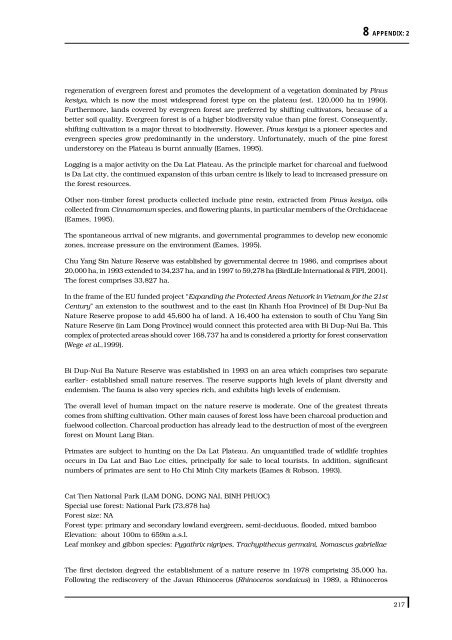Vietnam Primate Conservation Status Review 2002 - Hoang Lien ...
Vietnam Primate Conservation Status Review 2002 - Hoang Lien ...
Vietnam Primate Conservation Status Review 2002 - Hoang Lien ...
Create successful ePaper yourself
Turn your PDF publications into a flip-book with our unique Google optimized e-Paper software.
8 APPENDIX: 2<br />
regeneration of evergreen forest and promotes the development of a vegetation dominated by Pinus<br />
kesiya, which is now the most widespread forest type on the plateau (est. 120,000 ha in 1990).<br />
Furthermore, lands covered by evergreen forest are preferred by shifting cultivators, because of a<br />
better soil quality. Evergreen forest is of a higher biodiversity value than pine forest. Consequently,<br />
shifting cultivation is a major threat to biodiversity. However, Pinus kesiya is a pioneer species and<br />
evergreen species grow predominantly in the understory. Unfortunately, much of the pine forest<br />
understorey on the Plateau is burnt annually (Eames, 1995).<br />
Logging is a major activity on the Da Lat Plateau. As the principle market for charcoal and fuelwood<br />
is Da Lat city, the continued expansion of this urban centre is likely to lead to increased pressure on<br />
the forest resources.<br />
Other non-timber forest products collected include pine resin, extracted from Pinus kesiya, oils<br />
collected from Cinnamomum species, and flowering plants, in particular members of the Orchidaceae<br />
(Eames, 1995).<br />
The spontaneous arrival of new migrants, and governmental programmes to develop new economic<br />
zones, increase pressure on the environment (Eames, 1995).<br />
Chu Yang Sin Nature Reserve was established by governmental decree in 1986, and comprises about<br />
20,000 ha, in 1993 extended to 34,237 ha, and in 1997 to 59,278 ha (BirdLife International & FIPI, 2001).<br />
The forest comprises 33,827 ha.<br />
In the frame of the EU funded project “Expanding the Protected Areas Network in <strong>Vietnam</strong> for the 21st<br />
Century” an extension to the southwest and to the east (in Khanh Hoa Province) of Bi Dup-Nui Ba<br />
Nature Reserve propose to add 45,600 ha of land. A 16,400 ha extension to south of Chu Yang Sin<br />
Nature Reserve (in Lam Dong Province) would connect this protected area with Bi Dup-Nui Ba. This<br />
complex of protected areas should cover 168,737 ha and is considered a priority for forest conservation<br />
(Wege et al.,1999).<br />
Bi Dup-Nui Ba Nature Reserve was established in 1993 on an area which comprises two separate<br />
earlier- established small nature reserves. The reserve supports high levels of plant diversity and<br />
endemism. The fauna is also very species rich, and exhibits high levels of endemism.<br />
The overall level of human impact on the nature reserve is moderate. One of the greatest threats<br />
comes from shifting cultivation. Other main causes of forest loss have been charcoal production and<br />
fuelwood collection. Charcoal production has already lead to the destruction of most of the evergreen<br />
forest on Mount Lang Bian.<br />
<strong>Primate</strong>s are subject to hunting on the Da Lat Plateau. An unquantified trade of wildlife trophies<br />
occurs in Da Lat and Bao Loc cities, principally for sale to local tourists. In addition, significant<br />
numbers of primates are sent to Ho Chi Minh City markets (Eames & Robson, 1993).<br />
Cat Tien National Park (LAM DONG, DONG NAI, BINH PHUOC)<br />
Special use forest: National Park (73,878 ha)<br />
Forest size: NA<br />
Forest type: primary and secondary lowland evergreen, semi-deciduous, flooded, mixed bamboo<br />
Elevation: about 100m to 659m a.s.l.<br />
Leaf monkey and gibbon species: Pygathrix nigripes, Trachypithecus germaini, Nomascus gabriellae<br />
The first decision degreed the establishment of a nature reserve in 1978 comprising 35,000 ha.<br />
Following the rediscovery of the Javan Rhinoceros (Rhinoceros sondaicus) in 1989, a Rhinoceros<br />
217



